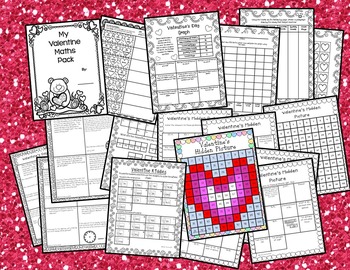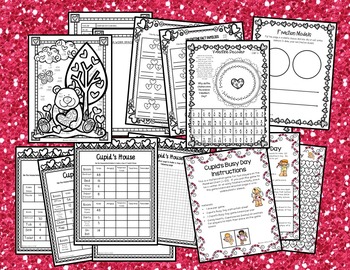Valentine's Day Maths Pack for Year 4
The Naturally Creative Classroom
1.7k Followers
Grade Levels
3rd
Subjects
Resource Type
Standards
CCSS3.MD.A.1
CCSS3.MD.A.2
CCSS3.MD.B.3
CCSS3.MD.C.5
CCSS3.MD.C.6
Formats Included
- PDF
Pages
61 pages
The Naturally Creative Classroom
1.7k Followers
Description
Your students will fall in LOVE with this Valentine’s Day Maths Pack! Everything from word problems to puzzles and games. This pack is perfect for review, early finishers, small groups, centres and guest teachers!
**All vocabulary, money and spelling are for the UK. You can find the US version HERE
This pack includes:
Valentine’s Day Word Problems
Graphing Data and Picture Graphs
Addition and subtraction to 1000 in a fun Colour by Answer
Ordering Numbers
Multiplication and Division fact families up to 100
Area with tiling and multiplication- Design a house for Cupid using the given units!
Comparing Fractions
Rounding to the nearest ten and hundred
Time and Money
A 100 Chart hidden pictures- solve 100 problems to find the Valentine picture!
Cupid’s Busy Day- a Multiplication Game for the hundred chart
**All vocabulary, money and spelling are for the UK. You can find the US version HERE
This pack includes:
Valentine’s Day Word Problems
Graphing Data and Picture Graphs
Addition and subtraction to 1000 in a fun Colour by Answer
Ordering Numbers
Multiplication and Division fact families up to 100
Area with tiling and multiplication- Design a house for Cupid using the given units!
Comparing Fractions
Rounding to the nearest ten and hundred
Time and Money
A 100 Chart hidden pictures- solve 100 problems to find the Valentine picture!
Cupid’s Busy Day- a Multiplication Game for the hundred chart
Total Pages
61 pages
Answer Key
Included
Teaching Duration
2 Weeks
Report this resource to TPT
Reported resources will be reviewed by our team. Report this resource to let us know if this resource violates TPT’s content guidelines.
Standards
to see state-specific standards (only available in the US).
CCSS3.MD.A.1
Tell and write time to the nearest minute and measure time intervals in minutes. Solve word problems involving addition and subtraction of time intervals in minutes, e.g., by representing the problem on a number line diagram.
CCSS3.MD.A.2
Measure and estimate liquid volumes and masses of objects using standard units of grams (g), kilograms (kg), and liters (l). Add, subtract, multiply, or divide to solve one-step word problems involving masses or volumes that are given in the same units, e.g., by using drawings (such as a beaker with a measurement scale) to represent the problem.
CCSS3.MD.B.3
Draw a scaled picture graph and a scaled bar graph to represent a data set with several categories. Solve one- and two-step “how many more” and “how many less” problems using information presented in scaled bar graphs. For example, draw a bar graph in which each square in the bar graph might represent 5 pets.
CCSS3.MD.C.5
Recognize area as an attribute of plane figures and understand concepts of area measurement.
CCSS3.MD.C.6
Measure areas by counting unit squares (square cm, square m, square in, square ft, and improvised units).




